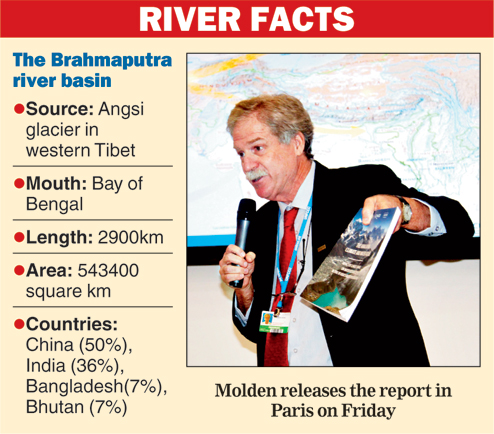
Guwahati, Dec. 11: If the present is not pleasant, the future would be equally grim, as people in the Brahmaputra basin will have to live with more floods and droughts till 2050.
This has been projected by Kathmandu-based International Centre for Integrated Mountain Development (ICIMOD) in its report The Himalayan Climate and Water Atlas: Impact of Climate Change on Water Resources in Five of Asia's Major River Basins. The report was released today at a side event of the Conference of the Parties (COP) 21 in Paris on International Mountain Day, titled Celebrating International Cooperation on Climate Change Adaptation in Mountain Environments - from Rio to Lima to Paris.
A first of its kind, the atlas released by David Molden, director-general of ICIMOD, offers a comprehensive, regional understanding of the changing climate and its impact on water resources in five of the major river basins in the region - the Indus, Brahmaputra, Ganga, Salween and Mekong - and will help develop solutions and take necessary action to deal with changes in the region.
The atlas, a joint initiative of ICIMOD, GRID-Arendal and the Centre for International Climate and Environmental Research-Oslo, uses maps and infographics to show how the region's climate is changing now and into the future.
The Brahmaputra undergoes a dramatic reduction in altitude as it passes through one of the world's deepest gorges in the Himalayas and enters the Assam plains, depositing large amounts of sediment downstream.
"The projections show that there will be more floods and droughts in the Brahmaputra basin till 2050," Arun Bhakta Shrestha, a senior climate change specialist at ICIMOD, told The Telegraph.
He said the Brahmaputra basin has been warming by about 0.5 degree Celsius in the past decades and the precipitation change pattern is mixed. In the eastern part of the basin, increasing trends have been observed. In the future, the basin is likely to warm by one to three degrees Celsius on an average. More areas of the basin are projected to get warmer in winter. Around 10 per cent increase in summer precipitation is projected by the middle of the century.
"In comparison to Indus and Ganga, the past and future changes in Brahmaputra basin are not much different," Shrestha added.
He said governments should lay stress on implementing flexible and diverse solutions to address the high level of uncertainty and implement structural and non-structural measures to adequately prepare for and manage extreme events.
The river is characterised by a large and variable flow.
The report said the current infrastructure does not allow all potential users access to the water in the Brahmaputra. Despite this, demand exceeds water availability in the driest months (January to March).
"As water infrastructure improves and access to water increases, the amount of water available downstream might be further reduced. During the dry months, the pressure on ecosystems may be critical," the report stated.

